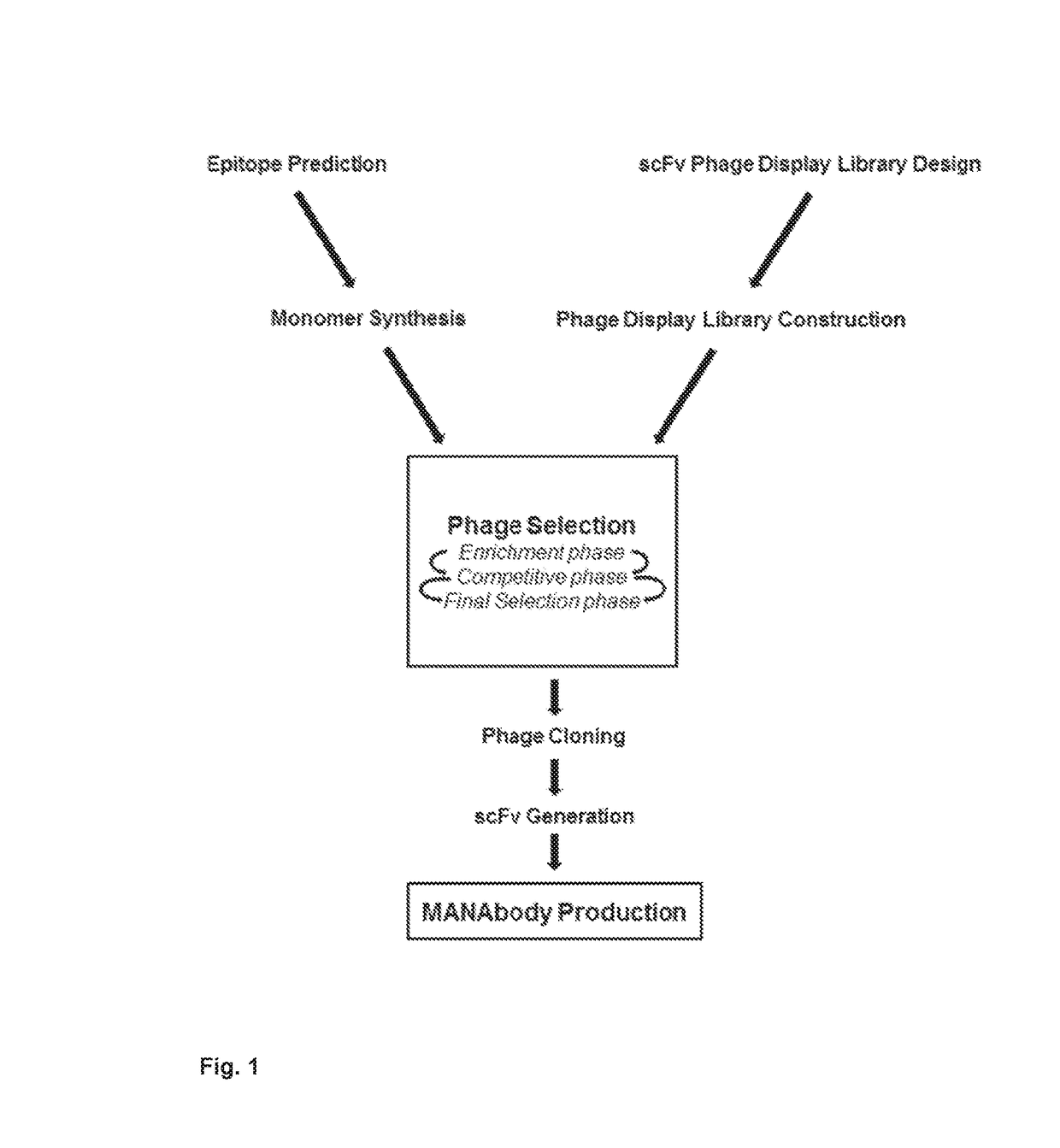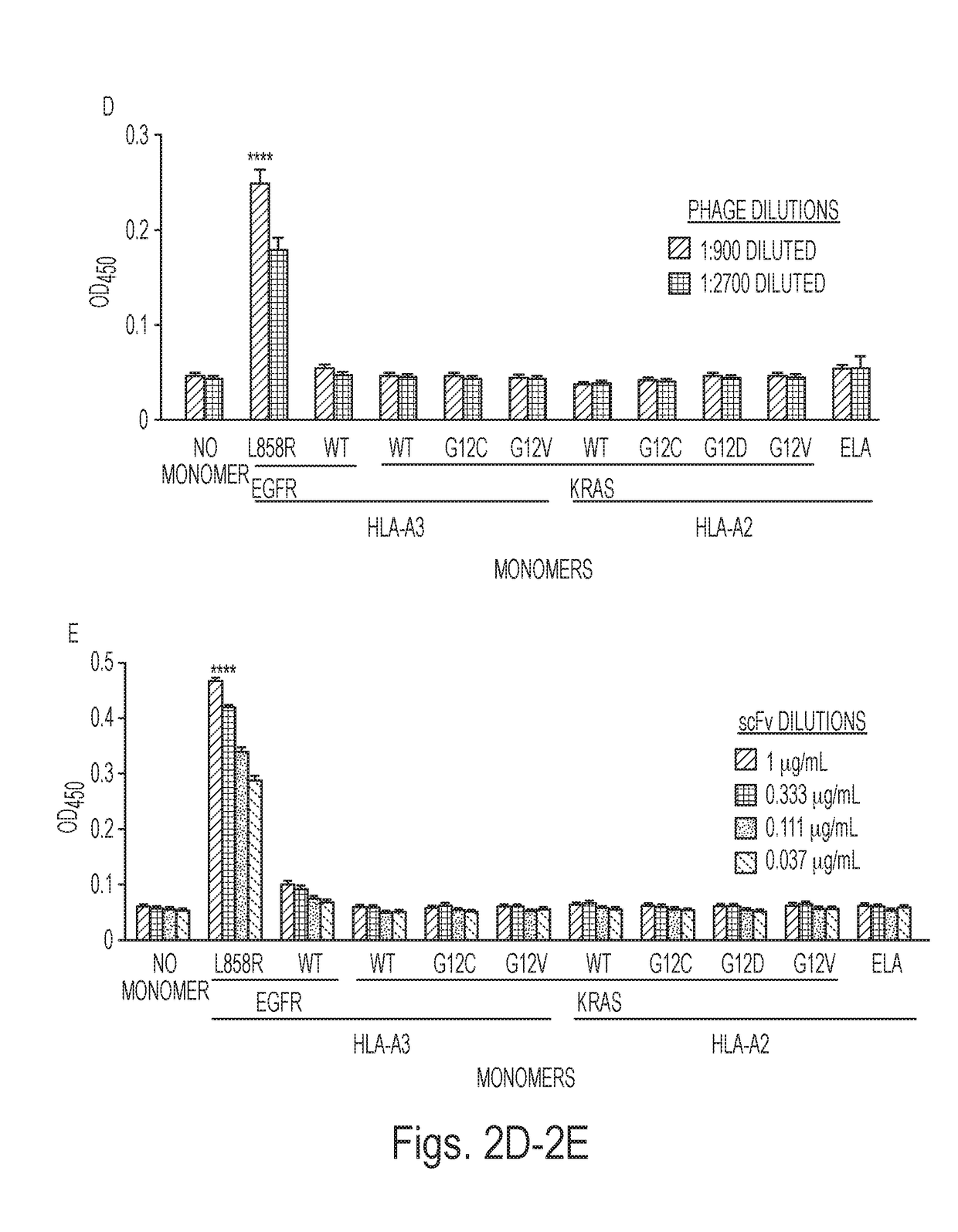Hla-restricted epitopes encoded by somatically mutated genes
a somatically mutated gene and restriction technology, applied in the field of antibody generation, can solve the problems of large-molecule access to intracellular proteins, large number of abnormal epitopes encoded by mutant genes not on the cell surface, etc., and achieve the effect of increasing the ratio of competitor complex to relevant complex
- Summary
- Abstract
- Description
- Claims
- Application Information
AI Technical Summary
Benefits of technology
Problems solved by technology
Method used
Image
Examples
example 1
Materials and Methods
[0046]Cell Lines. T2 cells (ATCC, Manassas, Va.) were cultured in RPMI-1640 (ATCC) with 10% FBS (GE Hyclone, Logan, Utah, USA), 1% penicillin streptomycin (Life Technologies), and 20 IU / mL recombinant human IL-2 (Proleukin™, Prometheus Laboratories) at 37° C. under 5% CO2. T2A3 cells (a kind gift from the Eric Lutz and Liz Jaffee, JHU) were grown in the same conditions as T2 cells but also with the addition of 500 ug / mL Geneticin (Life Technologies) and 1× Non-Essential Amino Acids (Life Technologies).
[0047]Phage Display Library Construction. Oligonucleotides were synthesized at DNA 2.0 (Menlo Park, Calif.) using mixed and split pool degenerate oligonucleotide syntheses. The oligonucleotides were incorporated into the pADL-10b phagemid (Antibody Design Labs, San Diego, Calif.). This phagemid contains an F1 origin, and a transcriptional repressor unit consisting of a lac operator and a lac repressor to limit uninduced expression. The scFv was synthesized with a p...
example 2
[0068]Design and construction of an scFv-based phage display-based scFv library. We began these studies with attempts to generate an antibody against a mutant KRAS peptide in mice (basis for this choice described below). Using conventional approaches to derive monoclonal antibodies after mouse immunization, these efforts failed, as no antibodies specifically reactive with the MANAs were identified. We therefore turned to phage display approaches for generating MANAbodies (FIG. 1). The design of the phage display library followed principles employed in published studies (22) and included some special features. The framework of the library was based on the scFv sequence of humanized 4D5 antibody (Trastuzumab), generated against the protein encoded by ERBB2 (23). This framework was chosen by virtue of its stability on phage and its ease of conversion to a soluble scFv, Fab, or antibody (22, 24). High-resolution crystal structures of the humanized 4D5 have identified the residues within...
example 3
[0070]Target selection and competitive strategy for identifying selectively reactive phage clones. We chose MANAbody targets based on the frequency of particular mutations and the strength of their predicted binding to HLA alleles. KRAS is one of the most commonly mutated genes in human cancers, with mutations particularly prevalent in pancreatic, colorectal, and lung adenocarcinomas. We chose the G12V mutation as the target because a relevant peptide containing it was predicted to bind with high affinity to the HLA-A2, which is the most common HLA allele in many ethnic groups (32). This in silico prediction was made using the NetMHC v3.4 algorithm (33-35). Additionally, the critical mutant residue (V at codon 12) was expected to be exposed on the surface of the HLA protein based on structural studies of other peptide HLA-complexes (36). The peptide KLVVVGAVGV (SEQ ID NO: 4), in which the valine residue (V) at position 8 represents the G12V mutation, was chemically synthesized by co...
PUM
| Property | Measurement | Unit |
|---|---|---|
| concentration | aaaaa | aaaaa |
| concentration | aaaaa | aaaaa |
| total volume | aaaaa | aaaaa |
Abstract
Description
Claims
Application Information
 Login to View More
Login to View More - R&D
- Intellectual Property
- Life Sciences
- Materials
- Tech Scout
- Unparalleled Data Quality
- Higher Quality Content
- 60% Fewer Hallucinations
Browse by: Latest US Patents, China's latest patents, Technical Efficacy Thesaurus, Application Domain, Technology Topic, Popular Technical Reports.
© 2025 PatSnap. All rights reserved.Legal|Privacy policy|Modern Slavery Act Transparency Statement|Sitemap|About US| Contact US: help@patsnap.com



